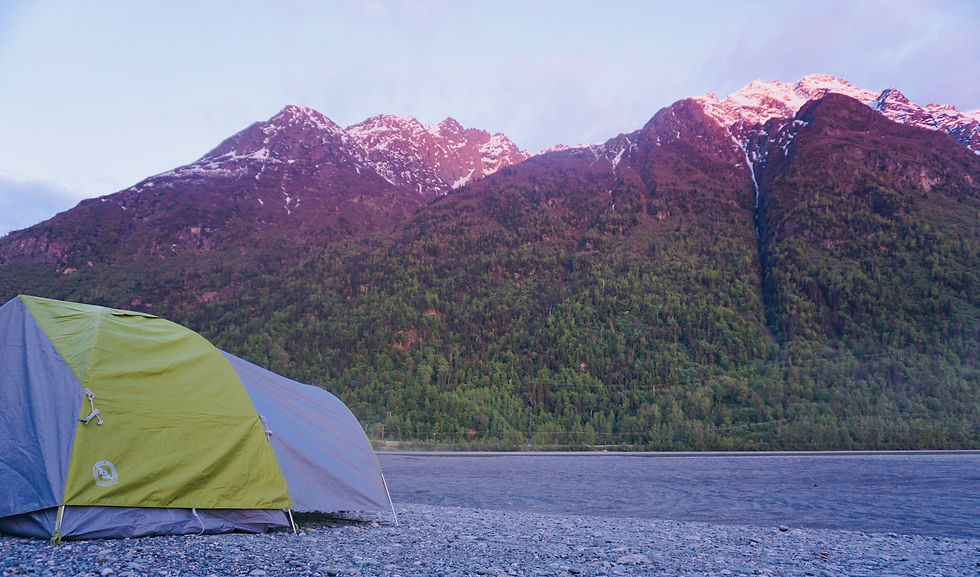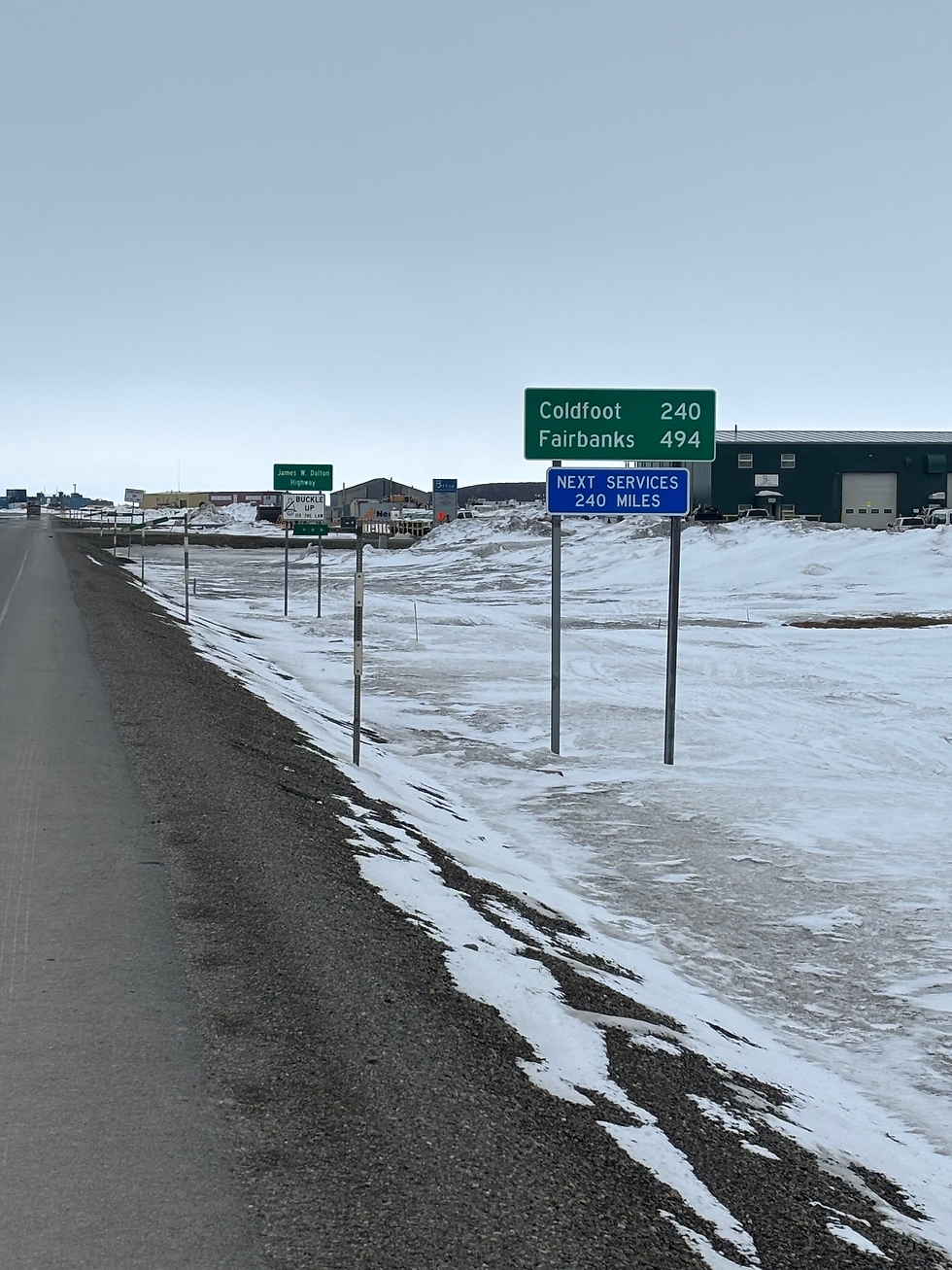The Starting Line: Planning and preparing for a bicycle tour across North America
- Tim Bolton

- Sep 12
- 8 min read

It was my second day out of Coldfoot, Alaska, on the Dalton Highway, one of the most rugged and remote stretches of road in North America.
It was hot - especially compared to the frigid tundra I’d ridden through days earlier. I’d just climbed a huge hill. Sweat was pouring down my back and face.
I needed to take a break.
I rolled into a parking area at the top of the hill and dismounted my bike, exhausted. I dropped onto a bench and sat looking back down at the valley I’d just ridden up, admiring the view and patting myself on the back for making it up another big hill.
A moment later, a car came flying into the parking area.
A woman leapt out of the driver’s door, phone in hand. She raced up to the spot where I sat. And, without even acknowledging me, she snapped a picture before hopping back into her car.
She peeled out of the parking area and was gone, leaving behind only a cloud of dust.
I watched her fly down the road it had taken me half an hour to ride up until she disappeared out of sight over another hill

I took a deep breath, inhaling the clear – albeit now dusty – Alaskan air. I lifted myself off the bench, mounted my bike, and pedaled away from the rest area at a snail’s pace on the long road back to Fairbanks.
Missing the forest through the trees
In the 21st century developed world, we have paved over, blocked out, and climate-controlled the natural environment our ancestors lived and thrived off of. All in the name of convenience and progress.
We live our lives online. We don’t have friends anymore. Instead, we follow them. Our neighbors live halfway around the world, and strangers live next door to us.
We view life – ours and the people we interact with online – in micro-moments. We see what others are eating but we aren’t sharing meals with them.
We take pictures of our pets and kids. We capture the events of our everyday lives and upload them into the collective conscience we call the Internet.
And we call it “sharing”.
But all the while we cling to our precious possessions for fear of losing what we really place our value in: Our status.
Being able to have a warm shower and a hot, home-cooked meal every day are amazing perks of modern life.
And the Internet has revolutionized the way we think, feel, and interact with each other in ways that are certainly net-positive.
But, in an age when AI and algorithms are becoming more and more capable of solving the problems we face and our quest for convenience has been all but completed, one question rises up above all others.
What purpose do we even serve any more?
Sparking a new adventure: My first bicycle tour

It started with a hunch.
If I lowered my overhead to a stupid-low level, I’d be able to see North America on my schedule, my budget, and my terms.
I could travel when and where I wanted. I could ride as far as the daylight and my leg muscles allowed.
I’d sleep on the ground on the side of the road, wake up when I felt rested, and eat when I was hungry.
I’d share the journey on social media in the hopes that others might slow down and make time to do what they’re passionate about.
I’d be able to help people prepare to set off on their own adventures – start their own businesses, reinvigorate their professional lives, or create lasting relationships – on their own terms, how they wanted.
There was just one small problem: I had absolutely no idea what I was doing.
Facing the guy in the mirror
I’d hardly had any previous experience with bikes. The longest ride I’d done previously had been just two days on a rented bike in Denali National Park.

It was cold and rainy the entire time. And I had to drag my bike across gravel banks and through freezing cold streams to get around the landslide that took out the Denali Park Road back in 2020.
Suffice it to say, it was a miserable ride. Not a good advertisement for bicycle touring.
So why not sign up for a group ride? There are plenty of organizations that sponsor cross-country rides to raise money for good causes.
I’d done group travel before during a trip to New Zealand during college. I loved seeing the country. But I hated doing it on someone else’s itinerary.
Being surrounded by people 24/7 and having no control over where we stopped, what we saw, or what routes we followed?
Yeah, no thanks.
I wanted to have my own experience. Unscripted. Self-guided. On my own.
Why not rent a van and drive? It would have been a quicker journey. And it would have been easier to get away from busy highways and see more cool places.
But I didn’t want to blow all my cash paying for gas. And I didn’t want to become like the lady I started this article talking about.
I didn’t want a windshield separating me from the outside world as I zipped through the country, snapping Instagram-worthy pics at one rest stop after another.

Taking a leap of faith
It came down to a choice for me:
Continue doing whatever I possibly could to scrape out a living and put bread in the bank, waiting for someone to come and save me,
Suck it up and find a job I hated but that paid two or three times more than I’d ever earned before until I had enough money to head all the way to Argentina,
Or throw everything I had at a solo bike ride across North America and trust myself that I could figure things out as I went.
I was done waiting for something to happen that catapulted me into the life I’ve always known I was capable of living.
I was fed up with having to bounce from place to place and job to job, crawling my way through life hoping things would work out.
And at first glance, the stability of a steady 9-to-5 with a 401(k) and health insurance sounds like the most anxiety-relieving means of making a living.
But for a guy who craves newness and fresh experiences every day, flying a desk for a living just wasn’t in the cards. I’d lose all my thirst for life – not to mention all the hair on my head. And probably balloon up to 400 pounds in the process.
So Option C became the winner.
I was going to ride a bicycle across North America.
Setting the ball in motion

Step One: Quit the steady 9-to-5 I’d just started because it wasn’t my cup of tea.
Step Two: Return to seasonal work for a year to save up, buy gear, do my research, and train.
Step Three: Burn the ships, hit the road, and don’t look back.
I started riding on May 15th, 2025. I began from the Land’s End Resort on the Homer Spit in Homer, Alaska.
My plan was to ride 600 miles north to Fairbanks on a training ride to test my gear, strengthen my legs, and see if the cross-country ride was really what I wanted to do.
It rained as I rode uphill out of Homer on Day One. Of course.
But I kept pedaling.
A couple days later, I arrived at the lodge I’d worked at the previous two summers and rested my legs there.
I chowed down on some delicious food, got a nice, warm shower, and slept on a mattress.
Then I kept pedaling.

North through the Kenai Peninsula to Anchorage. Up more hills, through more rain.
I stopped in Anchorage to rest up again and splurge on a massage. No regrets there.
Then I kept pedaling.
I visited Denali again and rode along the park road. Up SO. MANY. HILLS. Through hail this time. Because why not.
Then I kept pedaling.
I continued north and rolled into Fairbanks on a sunny Sunday morning, June 1st. My training ride was complete.
I could have stopped then and congratulated myself for doing something not many people do.
But I didn’t.
I stayed in town for a couple days to visit my storage unit and run some errands.
On June 3rd, I jumped on a flight, first back down to Anchorage, then north to Prudhoe Bay and the end of the Dalton Highway.
Choosing how to respond to setbacks
My ride to Key West, Florida, began on the evening of June 4th, a day later than I'd planned.

I’d sent two packages north ahead of time, one to Deadhorse, the other to Coldfoot.
When I arrived in Prudhoe Bay, I called the post office there, and the postal worker informed me that the Deadhorse package hadn’t arrived.
Are you kidding me?
I’d just ridden a bicycle 600 miles through southern Alaska. I’d even taken a couple off-days and a detour in Denali National Park. And I was supposed to believe the United States Postal Service couldn’t ship a package to its destination by plane or truck in that amount of time?
Yep, that seemed to be about the gist of it.
That was a problem. Because there are no services between Deadhorse and Coldfoot. It’s just 250 miles of tundra and mountains.
Suffice it to say, that put me in a bind. I wasn’t about to ride through remote Alaska without supplies. Especially since there were still winter conditions on the North Slope in early June.
So, I splurged on a room in Deadhorse overnight in the hopes that my package would arrive the next day.
I’ll spare you the suspense: The package still didn’t show.
Writing the first chapter
It’s in moments like these that I like to hit the pause button and review my options:
Option 1: Wait another day and see if the package arrived on June 5th.
Option 2: Grab what supplies I could from the small store in Deadhorse and hustle to Coldfoot to resupply.
The decision was an easy one for me to make.

All my life I’d spent waiting.
During high school, I sat on my parents' couch waiting for my friends to text me so we could hang out instead of going first and reaching out to them.
I spent my college years waiting to get my diploma because I thought it would make me certified smart and therefore worthy of that coveted steady job and paycheck.
And in my early adult years, I sent countless resumes and job applications out to companies that I’d never hear back from.
I was done waiting.
Still ticked off, I stocked up on what supplies were available at the Deadhorse store. And one of the employees at Deadhorse Camp was kind enough to give me some freeze-dried meals, a can of butane fuel, and some bear spray.
I was as prepared as I could be to brave the North Slope.
I checked out of Deadhorse Camp grateful for the generosity from the people there.
I bundled up to protect myself from the chilly tundra. And with one last look over my gear, I pointed my handlebars south down the Dalton Highway.
After over a year of planning, preparation, and anticipation, I was ready to make my way back down to Fairbanks.
I let out a long sigh to calm my nerves. Then I mounted my bike and clipped into one of my pedals.
It was finally time to ride.



Comments